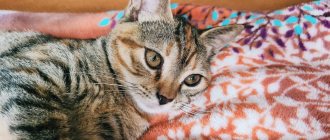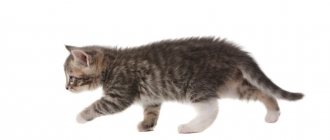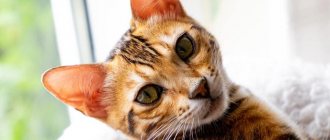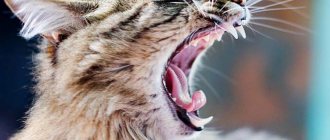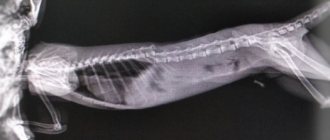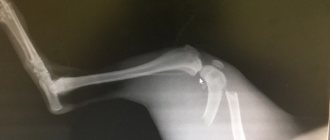Cats are active and very playful animals. Of course, there are extremely lazy individuals, whose most “outstanding” achievement is constant sleep and continuous eating, but still not a single healthy cat will refuse to run properly. Sometimes animals flirt in such a way that they do not behave quite “appropriately”.
And it happens that at this moment short-term convulsions develop: in a cat they often last a couple of seconds, which is why the owners do not have time to understand anything. Meanwhile, any convulsions and seizures, even if they last no more than a couple of seconds, are an extremely bad sign, indicating pathologies that are dangerous to the health and life of the animal.
What are cramps
The first thing all owners of “convulsive” animals need to know is that seizures and other seizures are not a disease in themselves, but they indicate pathological functioning of the brain or the nervous and muscular systems as a whole.
Note that convulsions most often begin in two opposite situations: either the cat is absolutely calm before it, or it is actively moving. It is almost impossible to predict their occurrence.
Cramps during sleep
Inexperienced owners often contact the clinic after noticing that in their sleep their pet makes movements similar to convulsions, during which the cat:
- eyelids and lips tremble;
- front or hind legs twitch;
- the tail is shaking.
Most often, such signs indicate a phase of REM sleep , after which the pet calmly continues to rest further. But if, after convulsive twitching, he jumps up sharply, loses orientation in space, makes loud sounds and looks scared, then this may indicate the development of a pathological process in the body.
Types of seizures
Regardless of the cause, all seizures can be divided into two large categories: local and generalized (generalized). Let's consider these options in more detail.
Generalized seizures
They are easiest to identify even for the most inexperienced owner: in such cases the cat can simply fall, shaking all its limbs, it is clear that the animal is in a semi-conscious state. In many cases, severe tremor of the facial muscles is observed, drooling profusely, and involuntary urination and defecation are observed.
As a rule, generalized convulsions rarely last more than three minutes. More precisely, cats rarely survive longer attacks. In many diseases (more precisely, in their first stages), soon after convulsions the animal fully recovers and often behaves as if nothing had happened. Rapid breathing will indicate what has happened.
Interesting! Such signs indicate severe brain damage - your pet may indeed not remember the seizures, since at that time she was in a state of “twilight consciousness.”
In other cases, immediately after an attack, the animal looks confused, depressed, and may behave inappropriately for some time. During this period, it is very desirable to provide the pet with complete peace and absence of stress, since any negative environmental factors can provoke a repeat attack.
Local convulsions
They are more typical for cats (if we compare them with dogs). Seizures in this case can be very difficult to detect. The problem is that not in all cases the cat’s hind legs (or forelimbs) actively twitch. Everything is much more complicated.
As in the previous case, cats may experience a sharp increase in salivation, foam at the mouth, twitching of the eyelids or facial muscles, excessive vocalization (the cat constantly and loudly screams), as well as strange and abnormal movements of the head and/or limbs.
In severe illnesses, seizures gradually progress to generalized ones, but situations are more common when their frequency and duration increase (first the front legs twitch, and then all the limbs).
Important advice: if you see that something is definitely wrong with your cat, it is very advisable to record this moment on video.
Let us note that even experienced veterinarians are not always able to determine the root cause of seizures if the appearance of the latter is caused by some difficult to diagnose pathologies of the nervous system. In such situations, encephalography is vital. This technique (expensive and rarely used in veterinary medicine) helps to accurately determine the state of the animal's brain.
But! It happens that seizures are not a sign of some serious pathology. Let's give a simple example. Cats, of course, cannot be considered avid swimmers, but sometimes they have to be washed, or the animal ends up in a deep puddle. Local “twitching” after bathing is a relatively normal phenomenon. This happens even to professional swimmers. Treated with peace and rest.
Primary and secondary seizures
Other veterinarians prefer to divide seizures differently: also into two types, but they are guided by the root cause and time of their occurrence. In this case, all seizures are divided into primary and secondary.
The latter are found much more often than the primary ones in veterinary practice. Simply put, secondary seizures are a consequence of some serious illness acquired by the cat during its life. These include: brain tumors, inflammation or infections (encephalitis), consequences of injuries, strokes (yes, they happen in animals too). Secondary status is indicated by the presence of other signs of the disease, such as vomiting, diarrhea, an increase or sharp decrease in body temperature, etc.
With primary seizures, they are also not the disease itself, but indicate severe functional disorders of nervous activity. In particular, persistent and unexplained seizures (which are not, however, epileptic) may indicate an imbalance between the number of “excited” and “inhibited” neurons in the brain, or some problems with the volume of neurotransmitters produced by the body.
In such cases, the first seizures are observed from an early age. However, such animals usually do not live to a relatively mature age. It is believed that no more than 29% are primary. As a rule, all diseases that cause their appearance are genetically determined and are not always diagnosed (due to the lack of appropriate technical equipment).
Symptoms of seizures
All types of seizures in cats have the following general signs:
- strong stretching of limbs;
- stiffness and muscle deformation;
- unnatural body posture;
- heart-rending cry of pain and fear;
- dilated pupils;
- rapid breathing;
- flattened ears.
In some cases, the animal is afraid to move, as the pain intensifies when moving. Sometimes, on the contrary, it tries to rise to its paws to no avail. When the hind limbs spasm, the cat falls on its side or remains in a standing position, but alternately stretches its paws back, as if stretching.
When the pharynx spasms, the animal drools or foams at the mouth. Involuntary urination and vomiting may occur. Other signs are classified depending on the type of seizure.
Causes of seizures in cats
The causes of seizures in cats are extremely varied and numerous, and therefore it is unrealistic to describe them in one article. They can be caused by both the most “extravagant” and rare degenerative pathologies of the brain, as well as more “mundane” causes (like poisoning).
Let us list the predisposing factors that practicing veterinarians most often have to deal with:
- Seizures are very characteristic of epilepsy , but with this disease they do not develop in 100% of cases.
- They are also frequent manifestations of poisoning. In particular, if strychnine enters a cat’s body, convulsions can be triggered even by birdsong (hyperexcitability of the nervous system).
- Oncological diseases (a common cause of seizures in an old cat).
- Lack of vitamin B1. Often found in cats. The reason is excessive feeding of pets with raw river fish. The fact is that this product contains a large amount of thiaminase. This is an enzyme that destroys B1. Considering that this vitamin is extremely important for the functioning of the central nervous system, the occurrence of seizures in such situations is not surprising.
- Cramps in general are often associated with nutrition. So, if a cat’s body does not receive the proper amount of vitamin B6 and magnesium, nothing good should be expected.
- Very often, seizures develop with renal failure . The reason is a drop in the level of free calcium in the blood serum. In such cases, the normal conduction of neuromuscular impulses is disrupted, which leads to uncontrolled contractions of muscle fibers.
- Allergic reactions. In particular, after vaccination (due to intolerance to the components of the drug).
- Hypertension (and in some cases also hypotension). Critically high or low blood pressure does not have the best effect on brain function.
- Reaction to some medications. In particular, convulsions after anesthesia can hardly be called an absolutely normal phenomenon, but it still happens quite often.
- Sudden temperature changes. In particular, cats have a very (!) hard time withstanding heat and stuffiness.
- Diabetes . One of its characteristic signs is precisely seizures that develop when blood sugar levels drop to a critically low level.
- Problems with the endocrine glands. Thus, pathologies of the thyroid gland can lead to too low levels of calcium in the blood. The result is tetanic convulsions. During estrus or immediately after childbirth, the likelihood of such attacks increases markedly.
Let's describe some of these reasons in a little more detail.
Pathological causes of tremor
The reason why the cat is trembling as if he is cold, although he is at home in comfortable conditions, may be pathological factors. In this case, tremor is often accompanied by the following clinical symptoms:
- photophobia;
- inactivity and lethargy;
- aggression;
- pain syndrome;
- increased body temperature;
- diarrhea or constipation;
- vomit;
- purulent discharge from the nasal cavity or eyes;
- impaired coordination of movements.
Often, the presence of pathology in a cat is indicated by trembling of individual parts of the body or muscle groups, when only the head, front or hind limbs shake.
Important! Tremor must be distinguished from convulsions, which are always accompanied by pain. In kittens up to 5-6 months of age, when their central nervous system is intensively developing, seizures can be physiological in nature. In other cases, seizures indicate the presence of serious disorders of brain function caused by infectious or traumatic factors.
There are many pathological reasons why kittens and adults tremble.
A deficiency of calcium and B vitamins in the body provokes degenerative processes in muscle tissue in cats.
The reason that the kitten is trembling may be infectious rhinotracheitis. In addition to tremor, this disease is accompanied by cough, purulent discharge from the eyes and nose, a significant increase in body temperature and digestive disorders.
With the development of helminthic infestations, when helminths clog the pet's intestines and release a huge amount of toxic products of their vital activity, the kitten experiences symptoms of intoxication, it becomes lethargic and trembles all over its body.
The body's response to the introduction of general anesthesia. If the cat shakes for more than 6 hours after surgery, this may indicate the development of internal bleeding. In this case, urgent medical intervention is necessary.
Body tremors in cats are provoked by acute inflammatory processes in the organs of the genitourinary system and attacks of urolithiasis.
Otitis media, caused by ear mites or other factors, leads to frequent head twitching. The cat scratches the sore ear, hits it, tilts its head towards the affected organ. As a result, scratches and hematomas appear in the ear area. Lack of treatment leads to inflammation spreading to the inner ear and meninges, which provokes death.
During acute liver failure, the cat develops vomiting and diarrhea; at the initial stage, it trembles slightly, and at the stage of failure of the affected organ, it trembles all over.
Head tremor may indicate traumatic brain injury, encephalitis, cerebellar lesions, or drug overdose.
If a kitten walks poorly and his whole body shakes, this may indicate spinal column injuries caused by congenital pathologies, compression or bruises. In adult cats, such symptoms are the result not only of injury, but also the development of tumors or deformation of the intervertebral discs.
If a kitten suddenly becomes lethargic, begins to tremble, first slightly, and then with increasing amplitude, then such tremors and lethargy most often indicate poisoning. If the baby is not taken to the clinic, he will develop seizures and die.
The cause of tremor may be borreliosis, which occurs after a tick bite. The insidiousness of the disease lies in its long latent period, when clinical signs may appear several months after infection.
Tremor combined with lethargy may be one of the signs of toxoplasmosis in cats.
If a kitten walks poorly, shakes, spins in place, or is poorly oriented in space, this may indicate that he has such a serious congenital pathology as hydrocephalus.
Tremors of the limbs, turning into convulsions, can occur in a cat during childbirth or within a week after it. This phenomenon is called eclampsia. It indicates an acute lack of calcium in the animal’s body. If left untreated, your cat will develop seizures, which can be fatal.
Convulsions during poisoning
As mentioned above, in case of poisoning, convulsions are a completely “normal” phenomenon. Of course, this is not always the case: such seizures are caused only by toxins that are part of the “convulsive” group. Note that in such cases, everything is usually in order with the animal’s nervous system. If you manage to remove the poison from your pet’s body in time and relieve convulsive seizures, there is a high chance of saving not only the life, but also the health of the cat.
It should be remembered that in case of poisoning, the intensity and duration of convulsions are sharply reduced immediately after gastric lavage or administration of blood substitute fluids (i.e., when the concentration of the toxin in the body decreases).
The most dangerous poisons that can cause such seizures are:
- Strychnine.
- Cicutotoxin.
- Bicycloorthophosphates.
- Silatranes.
- Cis-5,6-dichloro-2,2-dicyano-3,3-bis(trifluoromethyl)norbornane.
- Triazadisulfonoadamantane.
All of them are not very common, but seizures, the appearance of which is caused by poisoning, are quite common.
Why does this happen? The thing is that the same salts of heavy metals, destructive for all mammals, cannot cause seizures by themselves. But they can kill the liver, as a result of which the animal’s blood is literally “overwhelmed” by a stream of toxins. The latter, when they enter the blood, cause various and very severe side effects. They often cause chronic renal failure later, and we already know that kidney failure leads to problems with calcium levels in the blood...
Poisoning
When cats swallow toxic substances, the digestive organs are initially affected, and after the toxins are absorbed into the blood, the structural elements of the nervous system are destroyed. This is accompanied by clonic-tonic convulsions, vomiting, diarrhea, internal and external hemorrhages, and behavioral disturbances. Intoxication of the body, accompanied by convulsions, can also occur as a result of the accumulation of a large number of helminths in the intestines, releasing toxic products of their vital activity. This can be easily prevented by timely deworming of the animal.
Important! Many owners, not knowing what to do if their pet is poisoned, try to induce vomiting. But if an animal experiences convulsions, then it is strictly forbidden to do this, since there is a risk of vomit entering the respiratory tract, which will lead to suffocation and death.
Convulsions before death
Alas, we are all mortal. Our pets also have their own time limit. Seizures immediately before death are common. Is it possible to somehow understand that this particular seizure is the last in the cat’s life? Most likely (with the exception of hyperacute forms of diseases) this is real.
The seizures themselves in this case are the result of severe (and incompatible with life) changes in the cat’s body. The blood supply and oxygenation of the brain are disrupted, neurons die in the thousands, and normal life activity ceases.
As a rule, a cat does not die “out of the blue.” If he was ill for a long time, suffering greatly, or received a serious head injury in a fall or from a collision with a car, then his death, an extremely sad event, will definitely not be sudden.
Death spasms differ in their duration. From time to time, the appearance of lucid windows is noted, when consciousness returns to the animal for some time. In addition, such convulsions, unlike the “life” varieties, gradually subside, but the cat’s condition noticeably worsens in the intervals between them . Before immediate death, there are relapses of strong, powerful muscle spasms, when the cat's body can literally arch.
Death throes
In most cases, cats experience agony before death, preceded by a decrease in heart rate and respiratory movements. This leads to hypoxia, which provokes nervous phenomena such as convulsions. Tonic contraction and tremor of muscles can also be caused by insufficient oxygen supply to them and the death of nerve endings.
Some owners believe that if the cat does not make loud meowing sounds during the agony stage, then it is not in pain. But that's not true. Silence can be caused by paralysis of the pharynx or the individual characteristics of the animal.
The presence of pain syndrome is indicated by:
- dilated pupils;
- intermittent breathing;
- body immobility;
- complete detachment from the environment.
Important! If the pre-death atonal period lasts for many hours, then it is advisable to end the pet’s suffering through euthanasia. Despite the difficulty of making such a decision, it will be a manifestation of true humanity towards your pet. It is worth clearly understanding that pity in this case is a manifestation of weakness and selfishness, and not love and compassion!!!
Convulsions or epileptic seizure?
We have already mentioned epilepsy several times. What is it and how can you distinguish epileptic seizures from “regular” seizures? Currently, many researchers propose to consider it not one disease, but a syndrome that combines different pathologies that can cause functional disorders of brain activity. Be that as it may, this disease is accompanied by strong and characteristic seizures, which nevertheless develop over several years (there are cases of rapid progression, but they are not so common).
When it comes to differentiation, things are complicated. It is believed that with a single seizure it is impossible to talk about epilepsy, but nevertheless seizures (a characteristic sign of both seizures and epilepsy) become more frequent over time, so they are not a reliable differential sign. Without a number of diagnostic studies (which we will discuss below), it is impossible to make an accurate diagnosis.
But! In everyday life, it is believed that an epileptic seizure cannot develop in a dream: such seizures are more typical during periods of wakefulness. Ordinary convulsions occur at any time.
Epileptic seizures
A distinctive feature of epileptic attacks is the fact that the animal is unconscious . With all other types of seizures, consciousness is preserved. Clinicians distinguish 3 phases of the disease, the most severe of which is the seizure phase.
It is characterized by:
- clonic-tonic convulsions;
- profuse salivation and foam from the mouth;
- wheezing and shortness of breath;
- involuntary bowel movements and urination;
- tachycardia.
As the attack subsides, the animal regains consciousness, but for several minutes does not recognize the owners and does not orient itself in a familiar environment. After returning to normal, cats experience increased thirst and hunger.
Diagnostics
Unfortunately, there are many problems with diagnosing the causes of sudden seizures in veterinary medicine: often clinics simply do not have the equipment to reliably identify the primary disease (however, it is often not available in “human” hospitals either). In addition, in such cases it will not be possible to get by with a simple examination and history taking. A number of detailed diagnostic studies need to be carried out.
First, a blood test, including toxicology and biochemistry, is extremely important. The latter is needed to assess the condition of the liver and kidneys (we have already written about their role in the development of seizures above). Older cats should also have their blood pressure checked several times. Severe deviations from the norm often indicate diseases of the thyroid gland, kidney failure, as well as pathologies of the heart and blood vessels. All of them can directly contribute to the occurrence of seizures.
An MRI and an encephalogram are strongly recommended. These techniques make it possible to accurately assess the state of the animal’s central nervous system. They help diagnose intracranial causes of seizures, such as brain tumors, encephalitis, stroke, or some congenital malformations. Despite the complete painlessness of the procedure, anesthesia or the administration of powerful sedatives is desirable.
In the most complex and doubtful cases, they also resort to examining the cerebrospinal fluid, as it helps to identify many infectious diseases that affect the nervous system (listeriosis, for example). Of course, this technique is not cheap. In addition, there is always a certain risk that if it is performed incorrectly, the cat will remain disabled.
Therefore, veterinarians more often resort to more gentle (and cheaper) methods, including radiography and ultrasound. Ultrasound is used more often as it allows us to assess the condition of soft tissues. If for some reason it is impossible to carry out this procedure, they resort to contrast fluoroscopy.
It should be noted the importance of repeated tests and studies for oncological causes of seizures. Even if the operation is successful, there is no guarantee that after some time the tumors will not “grow” again.
First aid for seizures
If a pet has an attack, it is very important not to get confused and provide competent first aid.
- Transfer the animal to a flat surface, having previously covered it with a disposable diaper or piece of cloth.
- You cannot forcefully hold a cat in a certain position or try to open its jaws.
- Do not give anticonvulsants or painkillers orally.
- You can give the animal a massage, which consists of lightly stroking the cramped muscles.
After the seizure ends, you should take your pet in your arms, talk to him, calm him down, cover him with a warm blanket, offer water and food.
Important! Independent use of anticonvulsants is unacceptable. The appropriateness of their use and dosage should only be determined by a doctor.
Even a single attack of seizures must be reported to a veterinarian, who will conduct a full examination and determine the cause of its occurrence. In this case, you should talk in detail about its clinical manifestations, previous illnesses and injuries, changes in food or living conditions.
First aid
Is it really possible to do something for your pet at home? Although a seizure is a frightening experience for any cat owner, it is important to try to remain calm rather than intervene (this usually causes much more harm). Ensure that the cat is not at risk of injuring itself, for example by falling down stairs or a dresser.
Be sure to time the onset of the seizure. It is believed that relatively “harmless” convulsions last up to two minutes. If the seizure lasts longer than three minutes and your cat seems to be getting worse, call your veterinarian immediately.
Please note that you should not try to grab a “convulsive” cat with your bare hands. Your pet is not himself at this time, and therefore may be aggressive. In addition, when a cat has a cramp, it will easily rip you with its claws.
Veterinarians at this time advise wrapping animals more tightly in a soft blanket. And the point here is not in trying to warm the cat: with some types of seizures, this should not be done. But a “wrapped” cat will not fall out of nowhere, will not get hurt, and will not tear the owner’s hands to the bones (otherwise he will need first aid).
Important! Even after the condition has normalized, it is not recommended to leave the cat alone.
It is necessary to sit with the pet, talk to it tenderly, calming it down. However, the real need for reassurance does not always arise. In most cases, the animal still does not remember anything. In such cases, it is much more important to be closer in order to react in a timely manner if the attack recurs. Unfortunately, there is nothing else you can do for your pet. If the attack starts again, or you do not like the animal’s condition, call a veterinarian immediately.
Important! Never prescribe any medications yourself. You won’t be able to help the cat, but you can completely kill it.
However, some breeders talk about the permissibility of using Corvalol. A couple of drops of this product on the tongue will help calm your pet and ease subsequent seizures (if any).
Never give food or drink to an animal that has just had a seizure: water or food sometimes triggers a relapse, during which the cat can easily choke or choke to death. In addition, we recommend placing the cat in a room with a comfortable temperature, protected from drafts. This is especially important when cramps appear after surgery.
Types of seizures
Based on the nature of the seizures, an experienced specialist can make a preliminary diagnosis. To facilitate this task, there is a classification of muscle spasms.
- Tonic spasms are manifested by excessive muscle contraction lasting a short period of time.
- Clonic seizures are characterized by alternating muscle tension and relaxation, most often involving rhythmic twitching of the hind legs. Such contractions indicate damage to the nervous system and brain.
- Tonic-clonic seizures are characteristic of epileptic seizures, poisoning and some other dangerous pathologies.
Important! If you notice that your cat is having a seizure, you need to remain calm and try to remember all the details of the attack. This may seem immoral, but if there is another person next to the owner providing first aid to the animal, then you should ask him to take a video of what is happening to show the veterinarian. It should be understood that when it comes to saving the life of a pet, sentimentality is not appropriate.
Treatment
Treatment of attacks should first of all imply the immediate elimination of their root cause (if one has been identified).
Drugs
Of course, it is impossible to cure neurological disorders in animals (as a rule), but achieving a stable lifelong remission is quite possible. Therapy is usually considered successful when the number of seizures has been reduced by at least 50%.
In cases where seizures are a consequence of severe disorders of brain activity, the animal will have to be on medication for life. In such situations, phenobarbital, levetiracetam, zonisamide, gabapentin and pregabalin are actively used.
Prevention
Prevention plays an important role, including protecting the animal from stress and other negative environmental factors.
In other cases, therapy involves immediate relief from the underlying causes:
- Hormone replacement therapy, etc. It may also be relevant when seizures suddenly develop after sterilization (i.e. removal of the ovaries or testes).
- Broad-spectrum antibiotics.
- Antidotes for poisoning.
- Antihistamines if seizures develop after an injection or other type of medication administration.
- Surgery for injuries or tumors.
- Chemical or radiation therapy for cancer.
And if therapy does not give any visible positive results, then what to do in this case? A repeated course of diagnostics is recommended. Reasons for positive changes include: misdiagnosis (most often), inappropriate dosage, or development of resistance to the effects of the drug.
Once again we emphasize the importance of lifelong therapy. So, if your cat’s seizures are explained by the degradation of his thyroid gland, the use of synthetic hormonal drugs should not be interrupted: the animal’s body can no longer produce its hormones.
Even when switching your pet to another medicine, this should be done gradually. An abrupt cessation of supply can provoke new attacks. The question of reducing the dosage should only be decided by a veterinarian, and only in cases where there have been no new seizures for several months.
Causes
In order to select the correct and high-quality treatment, a specialist at a veterinary emergency center must first determine the reasons for this behavior of the animal’s health condition.
Possible reasons :
- One of the reasons may be epilepsy, which is a complex neurological disease. This diagnosis is made if other causes have already been excluded. First of all, after a specialist from the veterinary center conducted a thorough examination, he took a urine and feces test. He also conducted neurological examinations, an examination of the back of the eye, and monitored the general condition of the pet over time.
- As a result of metabolic disorders, various pathologies of organs, their failures, hypokalemia, hypocalcemia, as well as toxoplasmosis.
- Poor heart function.
- Parasites present in the intestines can also be causes.
- A variety of infectious diseases that are caused by bacteria, viruses and fungi.
- Tumors.
- If the animal is poisoned by chemicals.
Seizures in a cat: how to provide first aid
The owner of a sick cat must be on alert, because the paroxysm begins suddenly. The main task is to avoid injury during convulsions. The cat is placed on the floor, turned on its side, and covered with soft cloth. In this position, her tongue will not stick into her larynx during a seizure. They sit down next to each other and place their hand on the pet’s head. The tip of a teaspoon is inserted between the teeth to prevent the kitty from biting her lip.
All observations about the pet's behavior during an attack are recorded in a diary to be provided to the veterinarian during the interview. Such information will help establish an accurate diagnosis and prescribe treatment. A video recording of an attack becomes valuable information for a diagnostician. You need to take care of your hands and wear gloves. A cat cannot control its behavior during a seizure.
Symptoms and signs
Heavy salivation in a cat can be accompanied by various physiological changes. They are not difficult to spot.
Read also: Wolfberry poisoning
- The cat does not eat anything and is drooling. This happens with gastrointestinal diseases or viral diseases. At the same time, if you notice that your pet refuses to eat, but is drooling profusely, you should not leave everything to chance and it is better to contact a veterinarian.
- The cat stopped taking solid food, which he used to eat with great desire. This may indicate problems with the mouth, teeth, or digestive system. Also, hard pieces of food may fall out of the mouth, and the animal holds its head in an unusual position.
- Changes in cat behavior. Just like us, cats experience some discomfort when they are sick. This may affect behavior - increased aggressiveness or irritability is noticeable.
- The cat's eyes water and drool, she has difficulty swallowing food, she feels nauseous and vomits - symptoms associated with drooling that indicate digestive problems.
- The cat is drooling and has bad breath. If there are any problems in the oral cavity, the pet begins to frequently rub its face.
They may have a claw injury
Cat scratches are damn nasty and painful. Any pet owner knows this. And declawing may be the only way to reduce their damage.
However, we can sometimes make mistakes when declawing because they are unable to verbally express their pain.
So much so that you realize that this is the damage caused by the declawing session. They try to relieve the pain by twitching their paws.
If he's not injured, he may just feel uncomfortable about it. That's why cats swing their paws.
© shutterstock
Treatment: basic measures
Therapy for convulsive states is necessary in any case, but it is prescribed only after examining the animal. Therefore, all treatment is divided into stages.
Step one - diagnosis
The doctor asks the owner how the attacks manifested themselves and what they were accompanied by. When compiling an anamnesis, it is important to know what the cat ate the day before, how it behaved, and whether there were stressful situations or injuries.
Blood and urine tests are taken from the animal. The cat is sent for hardware examination (ultrasound, MRI). Only after collecting all the results does the doctor move on to the next stage.
Step two - choosing treatment tactics
In each specific case, an individual course of therapy is selected. First of all, it is necessary to act on the factor that provoked the cat’s seizures. Often an epileptic attack is stopped with Promidon.
Symptomatic treatment includes the following:
- prescription of analgesics;
- antiemetics;
- solutions that prevent dehydration;
- vitamin complex.
You can quickly eliminate cramps with Pagliferal or Phenobarbital.
But these injections are done only in a clinic under the supervision of a doctor, since the drugs are toxic and an overdose cannot be allowed.
Cat diseases part 2
Cystitis is an inflammation of the bladder mucosa caused by various reasons (inflammation of nearby organs - kidneys, uterus, etc.; injuries, irritants, etc.). The cat urinates with difficulty and often, possibly with blood, the temperature rises, and the bladder area is painful. While waiting for the veterinarian, you can give a drug with a general antiseptic effect - methenamine. You need to follow a diet - exclude meat for a while, replacing it with vegetable broth, switch to dairy foods.
Nephritis - can develop with plague, bronchopneumonia, or as a result of injury. The animal is depressed and has no appetite. Vomiting, difficulty moving the hind limbs. Urination is frequent and copious, often bloody urine, rapid breathing. Call a doctor immediately! Keep your cat warm and give her tea. Treatment should be started as soon as possible, as uremia may develop.
Bladder stones are common in cats, especially older ones. Urolithiasis manifests itself in difficult and painful urination. Treatment by a veterinarian is necessary, since an overfilled bladder can burst, and in general this is a serious metabolic disorder. A strict diet is required depending on the composition of the stones.
Eye diseases
Such diseases should be treated by a specialist. Depending on the diagnosis, he prescribes the necessary eye medications. It is very dangerous to show independence in treatment, since incorrect actions can cause a deterioration in the animal’s condition. The most common eye diseases are watery eyes (epiphora), conjunctivitis, eye damage, foreign body in the eye, third eyelid prolapse.
Lacrimation (epiphora).
Epiphora refers to lacrimation that goes beyond normal limits. Tears are a response to irritation. The causes of lacrimation can be: allergies, inflammation of the connective membrane of the eyes, conjunctivitis, damage to the cornea, blockage of the tear ducts. In addition, lacrimation can be a symptom accompanying mild infectious diseases, such as those of the upper respiratory tract.
Sometimes watery eyes cause a change in the color of the fur under the eyes, so the hair in these areas must be thoroughly washed, and in some cases even shaved.
Conjunctivitis is an inflammation of the cornea of the eye. It can occur as an independent disease, but can accompany infectious diseases. The first sign of inflammation of the cornea is lacrimation. In mild cases, conjunctivitis may go away on its own within 3-7 days, and in others, tear secretions become sticky, yellowish, and accumulate in large quantities in the corners of the eyes, then treatment is necessary.
In order to cure a cat of conjunctivitis, it is first necessary to eliminate the cause that caused it.
In a healthy cat, discharge from the eyes should be clear and watery; in a cat with conjunctivitis, it is usually sticky and opaque. If conjunctivitis does not go away within three days, you should consult a doctor. He will prescribe antibiotics, eye drops, and explain how to wash the eyes.
Damage to the eye, foreign body in the eye.
Severe watering and inflammation of the cornea may be signs that a foreign body has entered the eye or that the eye is damaged.
If lacrimation and inflammation of the cornea are accompanied by pain when blinking or washing with a paw, there is every reason to assume that the eye is damaged or a foreign body has entered it.
An eye examination to determine the causes of lacrimation must be carried out in bright light. To remove a foreign body, place the thumb of one hand on the edge of the lower eyelid and the thumb of the other hand on the edge of the upper eyelid. By pulling back the eyelids, you can examine the eyeball.
Compare the damaged eye with the healthy one. In a healthy eye, the upper surface of the cornea should be smooth and completely transparent.
If you find, for example, a speck or grain of sand in your cat's eye, carefully remove it with a damp gauze swab, moving it along the inner surface of the eyelid to the corner of the eye. If the foreign body is large, it can be removed with tweezers or even your fingertips.
If you are unable to remove the foreign body yourself, you should immediately consult a doctor.
Prolapse of the third eyelid.
The third eyelid (blinking eyelid) quite often falls out of its normal state at the inner corner of the eye and forms folds, sometimes covering part of the eye. Very often this is a sign of local irritation of the eye, for example, when a foreign body enters the eye or when the cornea is damaged.
Sometimes this happens in both eyes at the same time and lasts quite a long time - from several hours to several days. The cause of third eyelid prolapse may be a disorder of the gastrointestinal tract; other signs are loss of appetite, loose stools, vomiting.
After normal activity of the stomach and intestines is restored, the third eyelid returns to its normal position.
For more serious symptoms (high temperature, weight loss, complete lack of appetite), you should immediately consult a doctor.
Prolapse of the third eyelid can sometimes occur in a healthy cat. It usually goes away without treatment. Observe the cat for 1-2 days. If it does not go away within this time, you should consult a doctor, as this may indicate the onset of some disease and lead to undesirable consequences.
Ear diseases
Ear diseases in cats are quite common. The ear is a complex and delicate instrument that must be handled with great care. Ulcers may occur in the ears, the cat may develop ear scabies, otitis externa and otitis media, swelling in the ears may occur due to abscesses and hematomas, and foreign objects may enter the ear.
Ulcers.
When an ulcer occurs in the ear, a foul-smelling, thick discharge appears that dries, forming scabs at the entrance of the auricle. The cat scratches its ear with its paw and shakes its head. A more thorough examination of the ear will reveal significant ulceration.
Do not treat it yourself - take your cat to a veterinarian.
Ear scabies.
It is caused by very small reddish-brown mites, which cause great concern to the animal. The first symptom is ear twitching or violent head shaking. Later, the animal begins to intensively scratch its ear.
As first aid, you can use warm vegetable or olive oil (3-4 drops), which will soften the scab and make the animal feel better. More details
Otitis is an inflammatory process in the ear. A distinction is made between external otitis, which is inflammation of the part of the ear located outside the eardrum, and medial, which is inflammation of the middle ear.
The reasons that cause otitis in a cat can be different, but most often it is an ear mite or a foreign body that has entered the ear.
A cat with otitis media usually shakes its head and scratches its ears with its paws. Sometimes with this disease she holds her head a little to one side, since any change in the position of her head causes her pain.
With otitis media, discharge from the ears may also be observed, in severe cases even purulent. The inner side of the auricle of the affected ear is bright pink or red, swelling may be clearly visible, and an odor appears from the ears.
Otitis requires immediate and vigorous treatment, as it easily becomes chronic and can lead to irreversible changes in the hearing organs.
When treating otitis at home, use 70% isopropyl alcohol or medical alcohol, which is used to clean the ears 2 times a day. After cleaning, 1-2 drops of alcohol can be dropped into the ear and massaged at the base of the cat’s ears in order to enhance the effect of the medicine.
If there is no improvement after 3 days, you should consult a doctor. More details
Swelling on the ears occurs in cats in most cases due to abscesses. Abscesses are called abscesses, ulcers, accumulations of pus in organs or tissues as a result of the inflammatory process. Less commonly, swelling can occur due to a bloody blister that forms between the layers of the ear - a hematoma. The cat may develop severe scratching and even cysts; the animal, trying to get rid of the itching, constantly shakes its head.
If the cat does not have a fever or discharge from the swollen part of the tissue, then without the help of a doctor you will not be able to distinguish an abscess from a hematoma. For a hematoma, it is recommended to use cold lotions. Then you must immediately consult a doctor, otherwise the hematoma can lead to ear deformation.
The hematoma is often removed surgically or a special ointment prescribed by a doctor is applied, which has to be used for quite a long time, sometimes several weeks.
Foreign objects in the ear, such as plant particles or awns of grasses and spikelets, can lead to intense irritation. And if thorns get into the ear, the problem may worsen. All you need to solve it is good lighting, your calmness and a keen eye.
Diseases of the nose
These diseases are quite rare in cats. Most often they accompany other diseases. Nevertheless, any owner needs to know about them.
Sticky, watery, milky-white to yellowish discharge from the nostrils, sneezing, as a rule, are signs of some kind of infectious disease or disease of the upper respiratory tract.
Oral diseases
These diseases are often accompanied by difficulty eating, drooling, difficulty swallowing and bad breath. The origin of these diseases is different. These are inflammations, foreign bodies, tartar.
Inflammation.
Most often there is inflammation of the edges of the lips, gums, oral mucosa (including the tongue), tonsils and pharyngeal cavity. These diseases must be treated by a veterinarian who will determine whether they are infectious or not.
Inflammation of the gums (gingivitis).
Red, bloodshot gums can be a sign of gingivitis.
Only a specialist can make an accurate diagnosis. Since it is very difficult to carry out treatment at home, in such cases it is necessary to seek the help of a doctor.
Some cats are prone to this disease.
Foreign body in the mouth.
Cats that have a foreign body in their mouth try to get rid of it with the help of their paws, lips and tongue. The cat rubs its front paws around its mouth and works hard with its tongue. Often the mouth is not completely closed - it may also be a sign that the cat has a loose tooth (a common phenomenon, especially in old animals).
If your cat has something stuck in her mouth, calm her down and examine her mouth, tongue, and roof of her mouth under a bright light.
Most often, chicken bones, skins, threads, and even needles and pins get stuck in the mouth. If you find a foreign body in your cat's mouth, use your fingertips or tweezers to remove it. If you are unable to find an object in your mouth or cannot remove it, consult a doctor without wasting time. Anesthesia is sometimes used to remove a foreign body.
Tartar is a hard white or yellow or gray substrate, that is, deposits of various mineral substances, covering a cat's teeth. Tartar usually occurs in older animals.
They can cause inflammation and an unpleasant odor. The stones must be removed by a veterinarian.
Functional disorders and diseases of the nervous system
Cats are very vulnerable and easily excitable animals. Therefore, you need to take special care of your pet’s nervous system. This attention should be strengthened during puberty and during the animal’s adaptation after illness. The most common diseases and dysfunctions of the nervous system are hysteria, nervous crisis, convulsions and fits, and meningitis.
Hysteria in cats, as in people, is more common in females. It appears mainly during puberty. Heredity plays a certain role in the development of the disease. Nervous crises of unknown origin are noted. The animal either hides or bites everything and everyone indiscriminately. The crisis does not last long, followed by a period of depression and lethargy. It is very important, as with other symptoms of damage to the nervous system, to immediately consult a doctor. If there is nothing serious, we are simply dealing with a hysterical woman. In such cases, the cat is advised to be neutered and given sedatives.
Nervous crisis.
The animal is overexcited: the cat rushes from side to side, its movements are erratic. She seems to be looking for someone to bite or scratch, but does not recognize the owners. All this can end in convulsions and falling to the floor.
This condition can be caused by a number of reasons. These are plague, worms, ear diseases (itching from ear mites or pain from ear inflammation). It is necessary to immediately contact a veterinarian. All signs indicate that the situation is serious. While waiting for the doctor, place the cat in a quiet, fairly dark place, isolate it, and leave it alone.
Seizures in cats are extremely rare. A sick animal may experience anxiety, fuss, become angry, run into things and objects, and lose coordination. Sometimes there are muscle spasms, convulsive muscle twitching, and foam appears on the mouth. In these cases, you should immediately contact your veterinarian.
Seizures are just a symptom of a more complex disease, the causes of which lie deeper. The veterinarian will try to find out what is causing them. All that is required of you is to protect the animal from injury. Keep your cat in a confined space and do not touch her until the seizure ends and she calms down. After that, call a specialist.
Epilepsy.
These are convulsive seizures, accompanied by loss of consciousness and general sensitivity. An epileptic seizure is a painful condition that suddenly takes over a cat for a while, then releases, only to start again unexpectedly. During a seizure, a cat becomes completely helpless.
A seizure is usually preceded by a change in the cat's behavior: she is either excited and overly intrusive, or, conversely, depressed and indifferent to everything.
An epileptic seizure in a cat is an extremely sad and scary picture. It usually lasts only a few minutes ( 1-5 ), which seems like an eternity. Consciousness is confused, the cat does not hear, does not respond to its name, does not orient itself, does not see the people and objects around it.
Seizures can be large, with loss of consciousness, or small. They may be accompanied by salivation, urination, and bowel movements.
There are many reasons that can cause an epileptic seizure in a cat: consequences of brain injury, complications after an infectious disease, vitamin deficiencies, lack of mineral salts in food, poisoning, intoxication, the presence of parasites in the ear or intestines, prolonged overstrain of the nervous system.
You should not be afraid of a cat in a seizure state. During convulsive manifestations, the cat's twitching head must be supported, but so that the cat does not bite, or a soft bedding must be placed under it, that is, to prevent the possibility of traumatic injury. Treatment by a veterinarian is required.
Meningitis is an inflammation of the meninges. Caused by injuries, and also occurs as a complication of plague. In the first stages, the animal is restless, irritable, and has no appetite; the cat is vomiting, there are convulsions, signs of paralysis of the limbs. The pupil is contracted.
Place the cat in a dark, quiet place until the doctor arrives, you can put a cold compress on the head, and support the heart with coffee or strong tea.
Flu.
This condition is also known as pneumonitis, but do not confuse it with pneumonia. Abyssinian, Burmese and Siamese cats are most susceptible to cat flu. Fortunately, there is now an effective vaccine against it. This disease is not transmitted to dogs or people.
Among the first noticeable symptoms are sneezing and slight discharge from the nose and respiratory tract. The temperature rises to 40° C. This is followed by profuse salivation and apathy, followed by significant watery discharge from the eyes and nose. After one or several days, the discharge thickens and turns yellow, and the eyelids become swollen and puffy. As the disease progresses, ulcers may appear in the mouth, vomiting and dehydration may begin.
Consult your doctor, but do not take your cat to him without first making an appointment. The doctor may decide to visit you at home to avoid the risk of infecting other patients.
Feline leukemia is a viral disease. The virus in the cat's body appears and multiplies mainly in the bone marrow cells, where red blood cells arise. He attacks them, but does not kill them. The attacked blood cells become weakened, which leads to a significantly weakened cat's immunity against other diseases. Feline leukemia in itself is not destructive, it only prepares the conditions for other viruses. After suffering a serious infection with the leukemia virus, most cats even become immune to further infections.
A cat becomes infected through contact with an already infected cat, its urine, saliva or milk, or contact with its bowls and bed. The virus can be transferred by the placenta to unborn kittens. The incubation period lasts up to one year. The number of infected cats kept at home is insignificant, while in places where cats gather in large numbers, the infection rate of the virus is higher.
The insidiousness of this disease lies in the fact that we do not yet know the extent of its prevalence, since we do not have the opportunity to find out the number of domestic cats. Leukemia has no specific symptoms, and deaths are usually attributed to some other cause.
Feline leukemia has nothing in common with human leukemia, so mutual infection is excluded.
Cancer.
Cancer is the excessive formation of new tissue. The reasons for its occurrence are still unknown. These neoplasms (tumors) in cats appear in two forms. Benign tumors are usually characterized by slow growth and are usually located in one place, from where they can be surgically removed. Malignant, actually cancerous, tumors are characterized by rapid growth caused by the destruction of nearby tissues. Metastases usually develop in them, and even with the help of surgery it is not possible to save the body.
Tumors in cats most often appear in the liver, spleen, kidneys and, especially, in the stomach and mammary glands. Most cases occur between 4-8 years. Symptoms of cancer are not fully defined: periodic lack of appetite and low fever, diarrhea in some animals, constipation in others; Over time, the disorders disappear on their own, but then reappear. The most humane thing would be to operate on a cat if cancer is established, and if the hope for recovery is minimal, then not allow it to wake up after anesthesia.
AIDS, or immune deficiency syndrome, is called the plague of the 20th century. Panic over the incredibly rapid spread of this terrible deadly disease has not spared cats.
Feline immunodeficiency virus (FIV) is a lymphotropic lentivirus that causes acquired immunodeficiency syndrome in domestic cats. The immune and nervous systems are affected. The disease is characterized by slow, gradual development, polymorphism of clinical manifestations.
virus was first isolated in 1987 from a group of cats in the United States. Then the virus was discovered in Switzerland and other European countries (Great Britain, France, Holland). Today, the infection has become endemic in cats all over the world. Back to the top of the article
